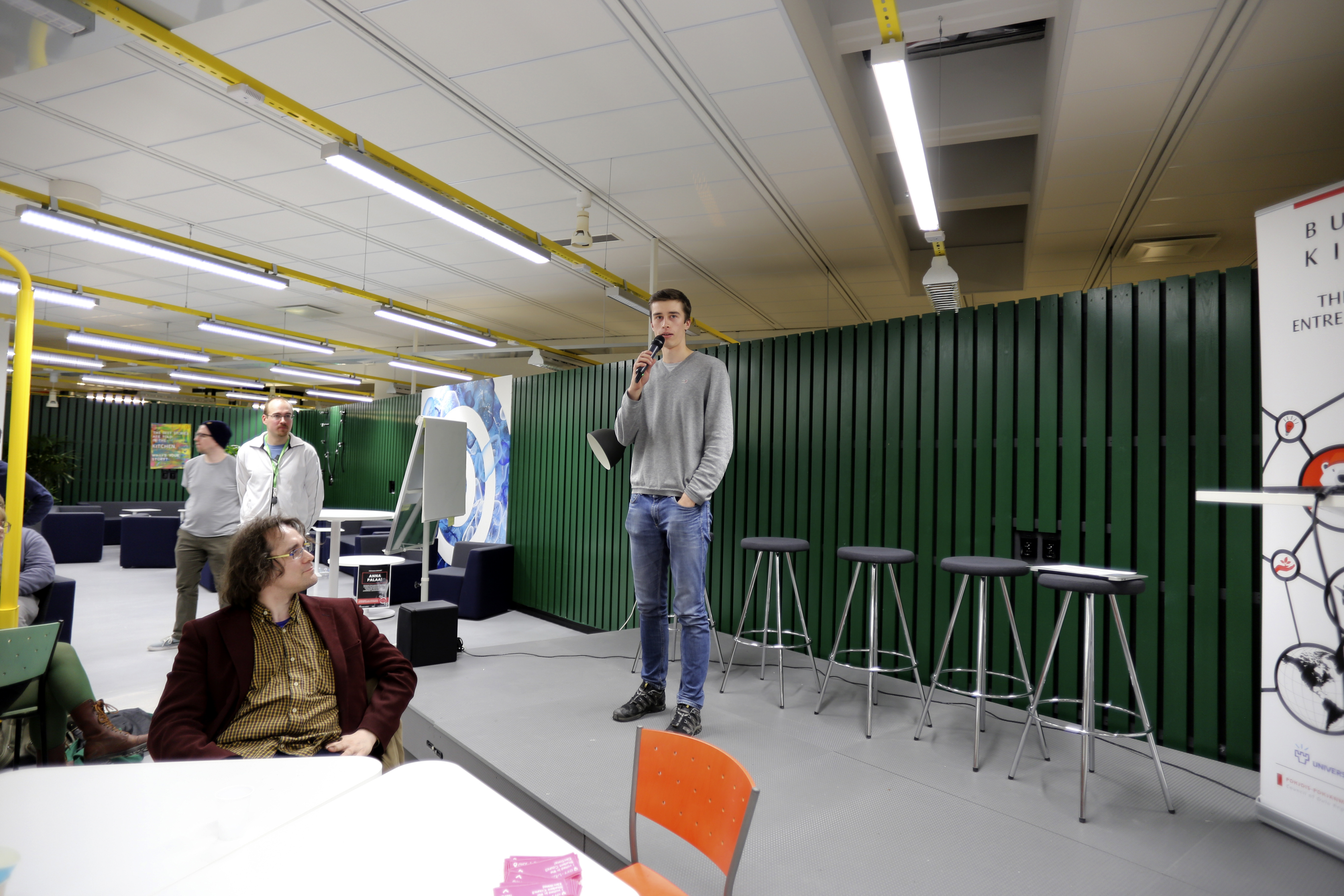The Student Union of the University of Oulu (OYY) has made a new arrangement regarding the provider for an electronic student card. At the end of summer, OYY has terminated co-operation with Frank Students and has made a contract with Pivo, which is part of OP Financial Group.
Pivo is a mobile app published in 2013 which can be used to pay in online shopping and cash registers as well as send and request money regardless of your own or the reciever’s bank. There is also a digital student card in Pivo which is used in 20 student associations – and now in Oulu as well.
In January students of the University of Oulu also gained access to student ID in the Tuudo mobile app. So from this fall onward students can use either the electronic student card found in Tuudo or Pivo’s card. The nationwide Frank App can still be used even though OYY has terminated their contract.
“Students can use the card under the JOLLA accumulator connection until we have a new register, after which we will confirm for example the student status of University of Oulu’s students using it”, says Frank’s CEO Tiia Lehtola.
Chair of Board Miriam Putula justifies the collaboration with Pivo by the fact that Pivo and Tuudo are different as service providers.
“Tuudo offers a platform for different services which a student needs. Pivo offers student privileges negotiated by Slice in addition to a card. The service concept is quite different, very similar to Frank.”
OYY’s board decided in August that it won’t renew the contract regarding the delivery of a student card with Frank. Putula won’t comment on the contents of the contract with Frank but she says it contained clauses which weren’t beneficial to the Student Union.
“We want to offer students as wide an array of services as possible and there were obstacles concerning that.”
After the contract with Frank has ended OYY will order new plastic student cards from Antenna. An ordered and operational Frank’s plastic student card can still be used as usual.
Pivo’s digital card has been in use for a few years in Tampere Student Union and beginning this August in The Student Union of the University of Vaasa as well. In Pivo’s app and website are also listed The Student Union of Lappeenranta University of Technology (LTKY) and The Student Union of the University of Eastern Finland (ISYY), although LTKY’s own website lists Frank as a student card provider and ISYY’s Frank and Pivo.
Oulu Student Magazine told about the upheaval of electronic students cards in the start of the year. You can read the story (in Finnish only) here.
Pivo and Slice to Co-operate
Pivo itself has had announcing to do in the late summer. Pivo and Slice, which was founded in the Satakunta region, announced their collaboration 7th of August.
Business owner Matti Rusila says that in principle the collaboration means that Slice can offer student benefits which it has negotiated to the organizations that have signed a contract with Pivo. Additionally, the organizations which used to be users of Slice’s own student card now came under Pivo’s card.
“Slice’s strength are benefits, we on the other hand have a big platform. Thus collaboration is a good choice.”
How does Pivo benefit from the collaboration? According to Matti Rusila Pivo wants to offer their card as widely as possible and be a significant actor in the market. Because student card market is — according to Rusila — quite fragmented, Slice and Pivo discovered that joining forces would be reasonable.
How Are You Doing, Frank?
But what’s going on with Frank Students? Frank was a pioneer of digital student cards in Finland: Frank App was launched three years ago. Although the idea of a digital card was thought of as progressive and good, the app got critiqued because of ads and various issues in using it.
Oulu Student Magazine talked about the critique in a story published earlier this year. One of the targets of critique was that the digital card needed to be paid for.
Frank App’s digital student card has again been available for free starting from the 25th of June. Now Frank’s digital card is free with or without Danske Bank’s plastic card with a payment feature. A new perk is also that the student gets a free five-year international ISIC student ID (worth 16 euros). When ordered from Frank, just the plastic card without the collaboration with Danske Bank costs 16,10 euros plus the delivery fee.
Earlier investment in developing the service is visible in Frank’s earnings. In the end of the fiscal year 2018, the equity ratio was negative 68 percent. Revenue was 952,000 euros last year and the profit was negative by 362,000 euros. That is, however, a fair rise compared to the year 2017 when the profit was negative by 674,000 euros.
Frank’s CEO Tiia Lehtola says last years numbers were what was aimed at.
“It’s a fact that there are big investments in the backround, growth requires investment. Starting from 2016, we have invested in the development of our digital service. In last year’s numbers, the operating profit, earnings and net sales excluding non-recurring items got better. It’s always an open question how to increase the slope of growth and we have open discussions concerning it.”
Now Frank is on the path which it wants to be on, Lehtola says.
“The early year’s results have been good. We are on the path we have planned and desired.”
When it comes to universities of applied sciences, Frank is currently only collaborating with the Student Union of Police University College (PolAmk) and the Student Union of Åland University of Applied Sciences. Others have terminated their contract.
“Of course we are sorry that student unions have not seen the added value in our service which we can provide. We would obviously want to be the one student unions choose because we believe that we are building additional value for student unions and we can work even better than before in recruitment of members in the future. We think collaboration between student unions is very important and that’s why we also develop new services for them – in addition to individual students”, Tiia Lehtola says.
Lehtola wishes that the organizations which have already terminated their collaboration would become interested in Frank’s services again: namely, the company would like to support the the recruitment of new members. When talking about new services aimed at organizations, Lehtola mentions communication related to student council election, which is aimed at student unions and will be piloted with Aalto University Student Union (AYY). In addition to this there will be “something cool” in store for subject societies.
“We’ll tell more about it when the time is right.”
SYL Not Intending to Sell
Frank is owned by travel agency Kilroy and the national student associations National Union of University Students in Finland (SYL), University of Applied Sciences Students in Finland (SAMOK), The Union of Upper Secondary School Students (SLL) and National Union of Vocational Students in Finland (SAKKI). With the sales made in 2017, Fank now owns the majority of Kilroy.
But what is the situation like for SYL, if their member student unions decide to give up Frank? Should student unions be owners in the future? After all, student unions of Oulu, Vaasa and Tampere are still owners of Frank through National Union of University Students in Finland (SYL). Tampere is different when compared to others in the fact that Frank was not used there in the first place. The higher education in Tampere didn’t take part in Frank or Lyyra, which preceded Frank.
He deems the choices made by student unions to give up co-operation to be regrettable. Still, the conversation with both Vaasa and Oulu has been good and constructive, he says.
“I got the impression that the possibility for co-operation in the future hasn’t been completely ruled out.”
“In a way I’d hope that people would understand the uniqueness of Frank. At least in the European countries that I am aware of, Frank is the only one in which student organizations are in a major arena, owning and making decisions. Seeing the value of that in student unions and the field of higher education would be great. But that is not enough in the modern world: there needs to be, obviously, a service students enjoy to use.”
Frank has garnered criticism from students in both App Store and Google Play and also at the SYL General Assembly last November. The General Assembly is the highest governing body of SYL, which gathers once a year, and to which every member of the union sends their delegation to decide the union’s course of action for the next year as well as economical questions and to choose the board for the coming year.
Eero Manninen says that last fall was hard. He understands why there was so much criticism, though.
“In hindsight, too many things were done in too short of a time. I get the discontent: the service wasn’t working as well as it should have. We went through the feedback together with Frank and the student unions. This year has been going smoothly. We hope that things will stay that way.”
Manninen says the criticism Frank got in the General Assembly was sudden, and that SYL hadn’t prepared for it. The conversation could have gone better, Manninen estimates.
“The conversation didn’t go deeper into ownership, the way things worked and the fact that the digital card wasn’t free were the points of discontent.”
Frank Opening for All
At the moment, students must be a part of a student organization co-operating with Frank to get their student card. This is changing, possibly even during this fall, Tiia Lehtola says.
Frank is currently preparing a second path for students to get Frank’s card, whether they are a member of a student organization, or if their organization is co-operating with Frank or not.
Lehtola won’t tell the launching date as of now.
“We’ll communicate when the matter becomes topical. The development of products is cyclical. But the initial schedule is that it would be in use this fall.”
Lehtola says that the change will be made in stages: this means the service won’t most likely be open to all students at the same time.
Will Pivo offer their student card in other ways than through an organization in the future?
“The confirmation of student status could be obtained in other ways that from organizations. We’ve thought that the fairest way is to co-operate with the organizations, which means offering the card to members of the organization,” Matti Rusila says.
The Future Looks Positive
The opening of student information records has opened a new kind of market for student cards.
Now that the card market is going through changes, why should organizations even own a single student card?
Eero Manninen, Secretary general of SYL, has many reasons for that. One the most important reasons hasn’t changed in these years of turmoil.
“The basic principle remains unchanged: the fact that we get to be a part of developing and telling our wishes to the largest company offering student ID. Getting up to date service which takes into account the wishes of students has a value of its own.”
Of course there is a possibility to make money by owning Frank, Manninen says.
“If we could get a hold of that market in a big way and go international, it would be a huge source of revenue. It’s been thought about ever since Frank was founded. Many commercial partners see it as a very significant added value that the national student organizations are a part of the company. The student organizations’ input is crucial to the other owner, Kilroy, as well.
With so many card providers and the option for both organizations and students to choose between a multitude of choices, why would they choose Frank of all the options?
Tiia Lehtola has a list of advantages. There’s integration with online shopping, ease of use and collaboration with ISIC to name a few.
A major selling point are the offered benefits, which means various student discounts: on Monday 19th of August, a quick search yields a trip to Thailand with as much as 70 percent discount, a student ticket to see the Helsinki Philharmonic Orchestra (8 euros) and a 25 percent discount in sportswear shop Stadium.
Local advantages for anyone who’s not from Helsinki are relatively scarce.
“We have focused on national benefits because we serve secondary and higher education students on a national level, and on known brands, because we have deemed them to interest students. But we also want to increase the offering of local benefits. Local benefits are at the moment free to enter our service”, Lehtola says.
Is going international still in the plans for Frank?
“It’s still a possible scenario for the future. We are investigating and having conversations of the matter. No decisions have been made.”
Where will Frank be in five years, Tiia Lehtola?
“Frank is a service for every Finnish student, or students studying in Finland. We have come to the situation that every student can find the benefits we offer. Our collaboration with ISIC has gone really well in Finland and we’ll see whether there is something to offer on an international level – I can see at least these things in my crystal ball. We’ll see what other developments there will be in the field.”
Eero Manninen, secretary general of SYL, feels positive about Frank’s future.
“We will see what the future has in store. Frank has a good product and the ideas for development are good stuff. Let’s hope that we’ll get things off the ground and that it would be a profitable business in the future and the national number one actor in the field in the future as well.”
But if SYL would end up selling their share, who would be making the decision? Eero Manninen considers this scenario to be highly unlikely but he estimates that, depending on the situation, the decision would be made either by SYL’s board or in an additional General Assembly.
“But I would hope, since it’s a business decision, that it would be something else altogether than a decision of organizational politics.”
Translation: Helmi Juntunen.





